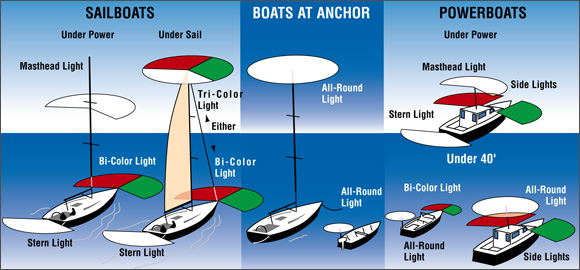| Navigation Light Rules |
 |
 |
Recreational boats operating at night are required to display navigation lights between sunset and sunrise. Recent changes to the Inland Navigation Rules make them nearly identical to the International Rules, so we will describe the International Rules to simplify the choices.
Basic rules:
- Sidelights are red (port) and green (starboard) and shine from dead ahead to 112.5° aft on either side.
- Stern lights are white and shine aft and 67.5° forward on each side. (Thus, the sidelights and stern light create a full circle of light.)
- All-round lights are white and shine through 360°.
- Masthead lights are white and shine from 112.5° on the port side through dead ahead to 112.5° on the starboard side. They must be above the sidelights.
- Sailboats under power are considered powerboats.
- Sidelights may be combined into a single "bicolor" light.
- Powerboats less than 20m (65.7') in length need to show sidelights, a stern light and a masthead light. Power vessels less than 12m may show a single all-round light in lieu of the separate masthead and stern lights.
- Sailing vessels less than 20m in length need to show sidelights and a stern light. These may be combined into a bicolor light and stern light, or a single tricolor light at the top of the mast. Sailing vessels under 7m must have an electric torch or lantern available for collision avoidance.
- Oar-driven vessels can show either the sailboat lights, or use the electric torch/lantern option.
- When anchored outside a special anchorage, power and sail vessels under 20m must display an all-round light. Vessels under 7m are exempt, unless anchored in a narrow channel or anchorage, or where other vessels usually navigate.
- Sailboats with sails up during the day, but which are also under power, must fly a black "steaming cone," with its point downward, where it can be seen. When under power they must follow the rules of the road for powerboats
Notes:
- Boats under power under 40' can substitute a single all-round light for separate stern and masthead lights
- Boats under 65'7" can substitute a single bi-color light for sidelights
- Sail boats under sail under 65'7" can substitute a tri-color light for separate sidelights and stern light.
- See our Anchor Ball
Definitions:
- All-Round Light: White ( 360°)
- Masthead Light: White ( 225°)
- Sidelights: Red (112.5°) & Green 112.5°)
- Stern Light: White (135°)

LED Lighting Technology
Light Emitting Diodes, more commonly known as LEDs, operate at lower temperatures, use less energy, tolerate vibration better and last far longer than conventional incandescent bulbs. They also do not contain small amounts of toxic mercury, an environmental disposal hazard associated with fluorescent and compact fluorescent lamp (CFL) lights. LEDs cost a bit more, but are worth their premium price in the long run. Here’s why:
Incandescent Bulbs Waste Energy
The light bulb, that marvel of technology created by Thomas Edison, operates by cramming a large volume of electrical current through a resistor encapsulated in a vacuum. This resistor, the tungsten filament, gets so hot that it glows white, and only the absence of oxygen prevents it from burning up in an instant. About 5% of the energy is released as light. The rest is mostly turned into heat, as we all know from burning our fingertips when we try to change a 60-watt bulb.
After more than a century, we’re still depending on Edison’s technology, but there are now cooler, more energy-efficient, and more “elegant” alternatives. In the very near future we’ll be seeing a lot more of them, mainly because they will reduce energy use and the production of greenhouse gasses. The Energy Independence and Security Act of 2007 requires roughly 25 percent greater efficiency for light bulbs, phased in from 2012 through 2014, beginning with the 100W bulb. This will effectively ban the sale of most current incandescent light bulbs. As of January 1st, 2011, standard 100W incandescent light bulbs have already been phased out of California stores. By 2020, bulbs must be 70 percent more efficient than they are today.
How they work
LEDs are diodes, semiconductors that allow current to flow in only one direction. Two materials are placed very close together in what is called a “P-N junction”. Run a current through the junction, and light energy is released
LEDs’ light color emission is determined by the chemistry of the device. There are two primary varieties of LEDs. The first, blue, white, green and ultraviolet LEDs use indium gallium nitride (InGaN).
Products
NAVIGATION LIGHT- UTILITY, WHITE, 225°
13.243.86
NAVIGATION LED LIGHT- EVOLED, WHITE, S/S, 60 cm
11.039.62
Special Price: 89.99 €
(Normal Price: 98.19 €)
NAVIGATION LIGHT- CLASSIC, 360°, S/S, PULL-OUT, 60 cm
11.164.01
Special Price: 56.99 €
(Normal Price: 67.92 €)
NAVIGATION LED LIGHT- INDEPENDENT, ROD WITH CLAMP
11.138.03
FOLDING GRAPNEL ANCHOR, 2.5 kg
01.139.25
Special Price: 18.99 €
(Normal Price: 21.96 €)
|